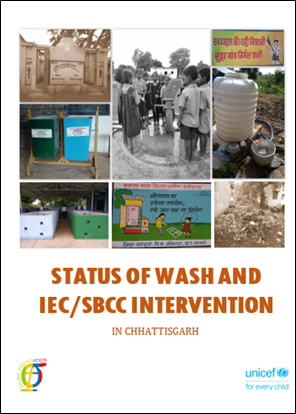Assessment of the Status of ODF Sustainability and IEC/SBCC Interventions in Chhattisgarh
Contributed By: Dr. M.N. Roy, Dr. Debasri Mukherjee, Ganesh Choudhary, Mayuri Sen, Debojyoti Majumder, Riyanka GhoshUNICEF Chhattisgarh Field Office engaged SIGMA Foundation as a partner to have an assessment of the status of ODF sustainability and IEC/SBCC interventions in the state. The objective of the study was to carry out an assessment of the status of ODF sustainability, the bottlenecks and the barriers for appropriate interventions to sustain the ODF status in the state.
The study was carried out in five districts namely Surguja, Durg, Bastar, Rajnandgaon and Raigarh. One district was selected from each division of the state to have proper coverage of the entire state in consultation with the Government of Chhattisgarh. The method of purposive sampling was followed to determine the number of survey units. The survey covered total 400 HHs, 60 primary schools, 40 high schools and 60 AWCs. Separate questionnaires were used to probe the issues related to each of the above units surveyed. Apart from that, to understand the knowledge, attitude and practice of common people, FGDs were conducted separately with men and women in each of the selected GPs. There were also interactions with the key officials at the state and the district level to understand the overall policy for implementation of SBM(G) at the state and the district levels.
The primary data from the survey as well as relevant secondary data was analysed and the report has prepared. The report has included key findings, recommendations for considerations of the state government. It was found that 88% HHs owned IHHL, 11% HHs had no toilet and in another 1% HHs the toilet was under construction. 3.2% IHHLs were defunct. On the other hand, 84.7% of the HHs used their own toilet for defecation whereas another 1.5% HHs used shared toilet or community toilet and 0.3% HHs used public toilet. The remaining 13.5% HHs were practicing Open Defecation. 60.3% HHs were following unhygienic practices in disposing child excreta. 98.3% primary and 95% schools had toilets. Children of 93.3% AWCs used toilet for defecation. Major activities related to ODF-S taken up by the GPs were Gram Sabha meeting, morning vigil by Nigrani Samity, regular announcements to maintain the cleanliness of the village, HH visit by SHG members and AWWs, wall writing and painting, nukkad natak etc. As a component of ODF Plus activities, the GPs were aware of only SLWM and they took up some activities on the same.

